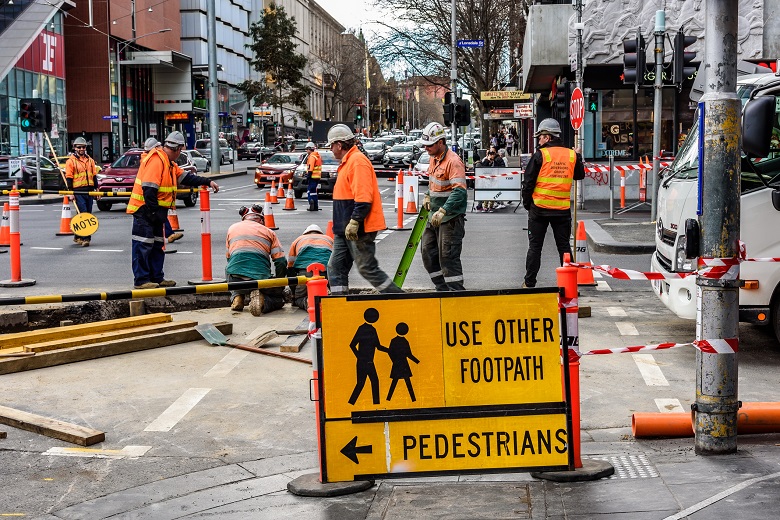
A national survey of local government raises concerns about the sector’s rapidly ageing and poorly skilled workforce.
The survey of the nation’s 242 councils, published by the Australian Local Government Association (ALGA) on Friday morning, lifts the lid on challenges facing the sector.
The report, conducted by the Local Government Workforce Development Group (LGWDG), analyses data from the ABS Census and a Local Government Skills Shortage Survey completed by almost half of Australia’s councils.
The data set is one of the first comprehensive profiles of the Australian local government workforce to date.
The report reveals a workforce of 189,500 employees who are considerably older than the general Australian workforce and a sector confronted with declining levels of participation of workers under 30, a substantial a shortage of apprentices and a major skills shortage.
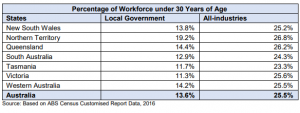
ALGA President David O’Loughlin on Friday urged all levels of government to work together to strengthen the local government workforce and laid out plans to lobby the Federal Government ahead of the anticipated May election.
“It’s a challenging picture and one which every council should be thinking about. We can only meet the needs of our communities if we have the staff to do the job. It requires all levels of government to be working to address these issues and I note for instance that one of the priorities for LGNSW in the impending state election is a commitment from the new government to address skills shortages,” he said.
“However, governments can only help when needs have been identified. Are you confident your council has identified its workforce development needs now and for coming years? And what can you first do locally, before asking other governments to help?”
“Critical” skills shortage
Councils are facing a massive skills gap and falling behind on soft skills, according to the report, which revealed almost 70 per cent of local governments are facing a skills shortage and skills gap.
As Government News exclusively reported last year, the survey found that councils are facing a shortage of key occupations, with engineers and town planners, building surveyors, and environmental health officers leading the list of in-demand occupations.
Meanwhile, local governments across Australia are facing a massive decline in apprenticeships, with 44 per cent saying they didn’t have enough apprentices to meet future skill needs as they grapple with a decline in apprenticeships of more than 60 per cent from 2012 to 2017, three times greater than the general workforce.
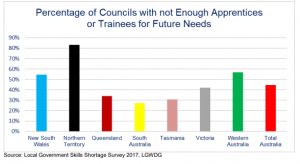
Councils were also found to be experiencing a massive skills gap, with 59 per cent saying that there was a gap between what employees were able to do and what they needed to do to perform their jobs.
A lack of training was found to be a key driver of the skills shortage, with 60 per cent of councils having unmet training needs due to high costs and a lack of local training options.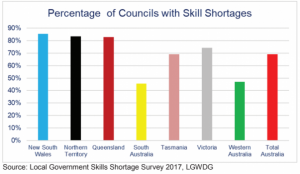
All council staff revealed the need to improve soft skills, in particular digital skills. Seventy per cent said they were poorly equipped for future digital demands with 70 per cent having done no forecasting of changing skill requirements arising from digital disruption.
There are major challenges in closing this skills gap, according to the report, due to a lack of qualified individuals locally and the inability of councils to compete with the private sector on remuneration.
There are also significant barriers to sourcing training including a lack of qualified trainers and the high costs involved with sending staff away to attend training, the report says.

Major decline in Indigenous workers
The survey also shed light on declining levels of Indigenous participation in the local government workforce, as Government News last month reported.
The report warns of a “major decline” in the numbers of Indigenous Australians working for local government in the Northern Territory and Queensland, and a drop reported in all states except Tasmania and Victoria.
Indigenous people make up 1.7 per cent of the local government workforce, down from 6.6 per cent in 2006, according to the Local Government Workforce and Future Skills Report.
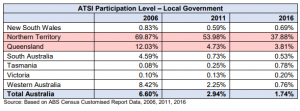
Councils to lobby Feds
The report has called on the national local government peak to lobby the Commonwealth to address these key challenges.
The recommendations would also see council associations engaging with training organisations to upskill staff through the design of qualifications and skills.
The peak would also commission research on the impacts of technology on the workforce under the recommendations.
Government News understands that the ALGA board met to discuss the report on Friday morning and will respond to the recommendations at a later date.
Comment below to have your say on this story.
If you have a news story or tip-off, get in touch at editorial@governmentnews.com.au.
Sign up to the Government News newsletter.


Hi
This worked for local govt about 10-20 years ago:
A percentage of budget for training
Traineeships, apprenticeships, graduate programs
These all went away with the decision to outsource and not adequetely plan for replacement of key employees and shifts in demographics and upcoming skills shortages and change in skills requirements (digital)
Outsourcing is part on the answer, not the whole answer; need to invest in people as an asset rather than consumables
Salary levels also have a lot to do with it. Why would the best people work in local government when they can earn more elsewhere.
Talk about “the elephant in the room “ – or choose not to, as this report does!!
The drivers of this crisis is exactly the same as the drivers of the asset management crisis also facing local governments at the moment. Namely – political shortsightedness and the general unwillingness to pay for the level of services demanded.
Politicians don’t get re-elected for fixing (or even ‘maintaining’) the sewerage system. They get re-
elected for more ‘visible’ and popular achievements.
Spending on training is a “stone parent less ( not politically correct to say ‘motherless ‘ any more) last” in the budget considerations of the politically ambitious.
There are councils that are the exception, but very few.
Executive management has been performing an incredible balancing act just to keep LG afloat to date. Getting the dregs of Federal and State funding, as well as the ever heightening public expectation of “everything for nothing”, is a fundamental flaw in the system that might be somewhat addressed but constitutional recognition for LG.
The ‘skills shortage ‘ is just the obvious by-product.